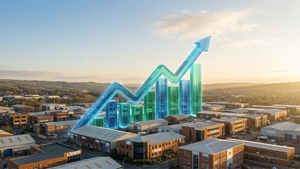Financial News
The Fed's Tightrope Walk: Navigating Rate Cuts Amidst Economic Crosscurrents

As November 2025 unfolds, the financial markets are grappling with a complex and often contradictory narrative emanating from the Federal Reserve. The central bank has recently embarked on a path of monetary easing, delivering two consecutive 25-basis-point rate cuts in September and October, bringing the federal funds rate to a target range of 3.75%-4.00%. This pivot, signaling a response to a softening labor market and moderating economic growth, has injected a fresh wave of anticipation and uncertainty into the global financial system. However, Federal Reserve Chair Jerome Powell’s subsequent hawkish commentary, cautioning against assuming further immediate cuts, underscores a deep-seated tension within the FOMC and a highly data-dependent approach that keeps markets on edge.
The immediate implications are a mixed bag for investors. Treasury yields, particularly on the shorter end, initially rose following Powell’s remarks as market expectations for aggressive future cuts were tempered. The 2-year Treasury yield surged, and 10-year yields pushed back above 4%. Equities experienced a brief pullback, though year-to-date performance remains robust. The U.S. dollar strengthened, reflecting the relative hawkishness compared to other major central banks. The probability of a December rate cut, once nearly a certainty, has significantly declined, forcing a recalibration of investment strategies across the board.
The Fed's Deliberate Dance: A Year of Pivots and Divisions
The Federal Reserve's monetary policy trajectory in 2025 has been a journey of careful calibration, marked by an initial period of holding steady before pivoting to strategic rate cuts. The year began with the federal funds rate in the 4.25%-4.50% range, following three cuts in late 2024.
Throughout the first half of 2025, the Federal Open Market Committee (FOMC) maintained rates, with unanimous decisions in January and May. However, signs of evolving sentiment emerged. In March, the FOMC removed language about risks being "roughly in balance," replacing it with a note on "increased uncertainty." It also began to slow its quantitative tightening (QT) program, reducing the monthly cap on Treasury redemptions. By July, internal divisions became more apparent, with Governors Waller and Bowman dissenting, favoring a 25bps rate cut when the majority voted to hold steady—the first such double dissent since 1993.
The decisive shift came in September, when the FOMC voted to cut the federal funds rate by 25 basis points to 4.00%-4.25%, citing increased downside risks to employment. This was followed by another 25-basis-point cut in October, lowering the target range to 3.75%-4.00%. Alongside this, the Fed announced the cessation of QT by December 1, 2025, signaling a move to stabilize its balance sheet.
However, the October meeting was immediately followed by Chair Powell's cautious remarks, emphasizing that a December cut was "not a foregone conclusion." He highlighted "strongly differing views" among policymakers and persistent inflation concerns, exacerbated by a U.S. government shutdown that has created a "data fog," obscuring the true economic picture. Dissenting voices continue to underscore this division; in October, newly appointed Governor Stephen Miran again favored a larger 50bps cut, while Kansas City Fed President Jeffrey Schmid preferred no change. These divergent opinions within the Fed, coupled with the reliance on incomplete data, paint a picture of a central bank navigating uncharted waters, with market reactions swinging between relief at easing and apprehension over future uncertainty.
Winners and Losers in the Evolving Rate Landscape
The Federal Reserve's current interest rate environment, characterized by a federal funds rate between 3.75%-4.00% and the prospect of a more gradual easing cycle, creates a distinct bifurcation of fortunes across public companies and market sectors.
Potential Winners:
- Financials: Banks, insurance companies, and brokerages are generally well-positioned. A federal funds rate in this range allows banks to maintain healthy net interest margins (NIMs), as they earn more on loans than they pay on deposits. Large banks like Bank of America (NYSE: BAC), JPMorgan Chase (NYSE: JPM), PNC Financial (NYSE: PNC), Huntington Bancshares (NASDAQ: HBAN), and Citibank (NYSE: C) can benefit from sustained interest income. Financial services firms like Charles Schwab (NYSE: SCHW), with its substantial cash reserves, also gain from higher interest income.
- Large-Cap Technology (with strong balance sheets): Established tech giants with significant cash holdings stand to benefit from earning higher interest income on their reserves. Companies like Apple (NASDAQ: AAPL) and Microsoft (NASDAQ: MSFT) are prime examples. Moreover, if the recent cuts signal cheaper capital, sectors like AI and cloud infrastructure could see increased investment. Nvidia (NASDAQ: NVDA) and Broadcom (NASDAQ: AVGO), key players in AI, could thrive if investment momentum continues.
- Consumer Staples: This defensive sector tends to perform consistently. Companies like Lamb Weston Holdings (NYSE: LW) offer stable revenue streams as consumers prioritize essential goods regardless of borrowing costs.
- Dividend Growth Stocks: Companies with strong cash flow that can consistently fund operations and pay growing dividends become attractive to investors seeking reliable returns in this environment.
- Industrials and Select Retailers: If the economy remains resilient, industrials (e.g., Ingersoll-Rand PLC (NYSE: IR), PACCAR (NASDAQ: PCAR)) can benefit from aerospace and reshoring trends. Retailers like Costco Wholesale Corp. (NASDAQ: COST) and Home Depot Inc. (NYSE: HD) could see continued demand.
- Clean Energy: Federal tax credits (e.g., Inflation Reduction Act) can boost demand and margins for solar companies like First Solar (NASDAQ: FSLR) and Enphase Energy (NASDAQ: ENPH), offsetting some higher borrowing costs.
Potential Losers:
- Real Estate (REITs, Residential Construction): Higher interest rates significantly increase mortgage and development financing costs, dampening buyer demand and making new projects unfeasible. Real Estate Investment Trusts (REITs) face higher refinancing costs, directly impacting earnings. Construction firms and developers, such as those that would work on projects by Lightpath Co., are particularly vulnerable.
- Capital-Intensive Industries: Companies heavily reliant on debt financing for large capital expenditures, such as utilities, extraction companies, and certain manufacturing sectors, face squeezed profit margins and potential delays in new investments due to higher borrowing costs. While Caterpillar (NYSE: CAT) might benefit from lower rates, a "higher for longer" scenario would pose challenges.
- Highly Leveraged Companies: Businesses that accumulated substantial debt during periods of historically low rates are now confronting much higher interest expenses as loans mature and require refinancing. This can erode profits and strain cash flow, particularly for firms with lower investment-grade ratings.
- Consumer Discretionary: Even with recent cuts, elevated interest rates on consumer loans can reduce disposable income, leading to cutbacks on non-essential purchases. Businesses in sectors like restaurants (e.g., Schlow Restaurant Group) and non-essential retail could see cooling demand.
- Small-Cap Growth Companies and Startups: These firms, often not yet profitable and heavily reliant on external funding, are disproportionately impacted by higher borrowing costs. They often have floating-rate debt, making them more vulnerable to interest rate fluctuations and refinancing risks.
Broader Implications: Navigating a New Economic Normal
The Federal Reserve's current interest rate outlook in November 2025 extends far beyond immediate market reactions, weaving into the fabric of broader economic trends, creating ripple effects, and posing significant regulatory and policy considerations. This period marks a critical juncture, as the Fed attempts to anchor stability amidst conflicting economic signals.
The ongoing battle against inflation, currently hovering around 3% (above the Fed's 2% target), remains paramount. While some argue that tariff impacts inflate this figure, the persistence of elevated prices is a primary driver of the Fed's cautious stance. Simultaneously, the labor market is showing signs of moderation, with a slight uptick in unemployment to 4.3% in August and decelerating payroll growth. This delicate balance between price stability and maximum employment is further complicated by a "data fog" caused by the U.S. government shutdown, forcing the Fed to rely on less comprehensive private sector data for its assessments. Despite these headwinds, GDP growth continues at a moderate pace, partly fueled by significant investments in Artificial Intelligence (AI).
The ripple effects are extensive. For financial markets, the Fed's hawkish tone on future cuts has led to higher Treasury yields and a stronger U.S. dollar, impacting global capital flows and currency valuations. While equities saw an initial dip, lower borrowing costs over time are generally expected to support corporate profits and stock prices, especially for growth-oriented tech firms. The real estate sector stands to benefit from potentially lower mortgage rates, stimulating demand. Internationally, Fed policy influences other central banks and impacts emerging markets, particularly those with dollar-denominated debt. For households and businesses, cheaper borrowing costs can spur investment and consumption, though savers may see diminished returns.
From a regulatory and policy standpoint, the government shutdown's disruption of economic data is a major concern, potentially leading the Fed to adopt an even more cautious approach. Discussions around potential fiscal stimulus in early 2026, such as tax cuts, will interact with the Fed's monetary policy, creating a complex interplay. The Federal Reserve is also undergoing a 2025 review of its monetary policy strategy, tools, and communications, alongside ongoing efforts to refine bank regulations, reduce burdens for community banks, and ensure financial stability while fostering innovation.
Historically, this period echoes past instances of "hawkish cuts," where the Fed eased policy but signaled caution, such as in 1998 under Alan Greenspan or the "mid-cycle adjustments" of 2019. The current struggle to balance inflation and employment also draws parallels to the aggressive anti-inflationary measures of the Volcker Fed in the 1980s. While rate cuts typically aim to stimulate economic activity, the risk of fueling inflation, as seen post-COVID, remains a significant consideration. The Fed's current trajectory signifies a continuous adaptation to evolving economic conditions, learning from past cycles of tightening and easing to navigate a new economic normal.
The Road Ahead: Scenarios and Strategic Shifts
The path forward for interest rates, as perceived in November 2025, remains highly dependent on the interplay of incoming economic data, the Federal Reserve's internal dynamics, and external geopolitical factors. While a clear easing cycle has begun, its pace and ultimate destination are subject to various possibilities.
Short-Term (Late 2025 - 2026): The immediate outlook hinges on the resolution of the "data fog" from the government shutdown. While a December rate cut is now less certain, an additional cut in early 2026 remains a strong possibility if labor market weakness persists and inflation continues its descent. However, if data proves mixed or inflation proves stubborn, the Fed could opt for a pause to gather more information. The bond market's yield curve, currently U-shaped, might normalize into a consistently upward-sloping curve by late 2026 as recession fears subside.
Long-Term (2027 and Beyond): The Fed's own projections suggest a gradual easing towards a federal funds rate near the estimated longer-run neutral rate of 3.0% by 2027-2028. However, the "higher for longer" debate persists, with some economists arguing rates might stay above 2.5% until late 2026 to prevent inflation resurgence. Conversely, a significant economic slowdown could prompt more aggressive easing, with rates potentially reaching 2.25%-2.50% by 2027, as projected by some analysts like Morningstar.
Potential Strategic Pivots: A dovish pivot (more aggressive cuts) could occur if the labor market deteriorates significantly or economic growth slows sharply. Political pressures, such as the upcoming end of Chair Powell's term or potential influence from a new administration, could also sway policy. Conversely, a hawkish pivot (pause or even renewed hikes) would be triggered if inflation re-accelerates unexpectedly or the economy demonstrates surprising resilience, forcing the Fed to prioritize price stability.
Market Opportunities and Challenges: Opportunities may emerge in fixed income, particularly U.S. high-yield and municipal bonds, in a non-recessionary easing scenario. Real estate valuations could see a tailwind from falling rates, and gold might perform well as a hedge in risk-off environments. Challenges include persistent market volatility due to uncertain data and divergent Fed views, the risk of prolonged inflation, and the potential for equity and other risk assets to struggle if a full-fledged recession takes hold. Investors will need to adapt their strategies to these dynamic scenarios, favoring agility and a keen eye on evolving economic indicators.
The Investment Compass: Navigating the Fed's Nuanced Path
As the Federal Reserve navigates a complex economic landscape in November 2025, investors face an environment of cautious optimism tempered by significant uncertainty. The recent rate cuts, while a welcome signal of easing, are not a green light for aggressive risk-taking, given the Fed's divided stance and data-dependent approach.
Key Takeaways: The Fed has pivoted to easing, with two 25-basis-point cuts, bringing the federal funds rate to 3.75%-4.00%. Quantitative Tightening is ending. However, Chair Powell's hawkish tone post-October and internal FOMC dissents underscore persistent inflation concerns and a cautious outlook on future cuts. The ongoing government shutdown has created a "data fog," making the Fed's assessment and market forecasting more challenging.
Market Moving Forward: Expect continued volatility as markets digest incoming data and Fed communications. Treasury yields have adjusted upwards, reflecting tempered expectations for rapid easing. Equity markets will likely remain sensitive to inflation and employment figures. The U.S. dollar may maintain strength if the Fed's stance remains comparatively hawkish. The probability of further immediate cuts has diminished, leading to a recalibration of market expectations for 2026.
Significance and Lasting Impact: This period signifies a critical balancing act for the Fed between supporting a softening labor market and combating elevated inflation. The "new dynamic" of a divided Fed and muddled economic signals suggests that a murky outlook for interest rates may persist, influencing borrowing costs for years to come. While real estate may see a tailwind from lower long-term rates, banks face a mixed outlook, with potential for rising loan losses despite stable net interest margins. The cessation of QT removes a tightening force, but the broader impact will be subtle.
What Investors Should Watch For:
- Inflation Data: Closely monitor the upcoming Consumer Price Index (CPI) report (due November 13) and core Personal Consumption Expenditures (PCE) services inflation. Any upside surprises could prompt the Fed to pause or even reconsider its easing path.
- Employment Data: The November jobs report will be crucial. A continued slowdown in job growth or a significant increase in the unemployment rate could accelerate the Fed's rate-cutting decisions.
- Fed Communications: Pay meticulous attention to FOMC meeting minutes, statements, and speeches from Fed officials. Subtle shifts in language or an increase in dissenting votes can signal changes in future policy.
- Government Shutdown Resolution: The swift resolution of the U.S. government shutdown is vital for restoring the timely flow of official economic data, which is critical for both the Fed and market participants.
- Global Economic Developments: Keep an eye on global growth trends and geopolitical events, as these can indirectly influence the Fed's domestic policy decisions.
For bond investors, a strategy favoring intermediate-term bonds (five to ten years) might offer a balance between reinvestment risk from very short-term investments and interest rate volatility from very long-term bonds. Mortgage borrowers, seeing rates at 2025 lows, might consider locking in rates, with an eye on refinancing if rates fall further. Above all, agility and a deep understanding of the Fed's data-dependent approach will be paramount in navigating the months ahead.
This content is intended for informational purposes only and is not financial advice
More News
View More




Recent Quotes
View MoreQuotes delayed at least 20 minutes.
By accessing this page, you agree to the Privacy Policy and Terms Of Service.



